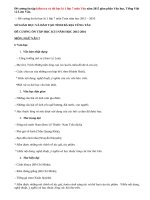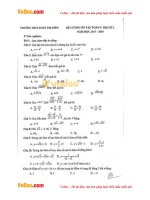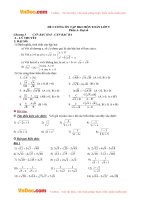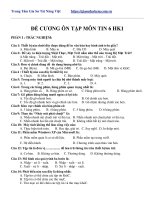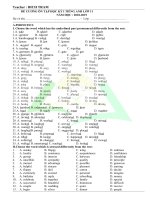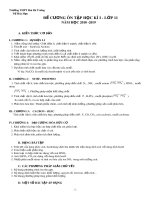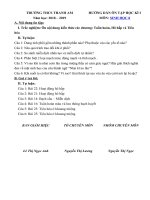Đề cương ôn tập học kì 1 lớp 6
Bạn đang xem bản rút gọn của tài liệu. Xem và tải ngay bản đầy đủ của tài liệu tại đây (205.89 KB, 19 trang )
THE PRESENT SIMPLE TENSE
(THÌ HIỆN TẠI ĐƠN)
I. Cấu trúc
1. Cách chia động từ "to be” ở thì hiện tại đơn như sau:
Thể
Khẳng
Chủ ngữ
To be
I
am
I am a pupil.
He/She/lt/danh từ số ít
is
She is a girl. He is a pupil.
You/We/They/ danh từ số nhiều
are
They are boys. We are
pupils.
I
am not
I am not a boy.
He/She/lt/danh từ số ít
is not
She is not a pupil. He is not
a girl.
You/We/They/ danh từ số nhiều
are not
They are not girls. We are
not pupils.
Am
I + ...?
định
Phủ
định
Vi du
Am I a pupil?
Yes, I am/ No, I am not.
Is she a boy? Is he a pupil?
Nghi
Is
vấn
he/she/it/danh từ
Yes, he/she/it is.
số ít +...?
No, he/she/it isn’t.
Are they pupils? Are we
boys?
Are
you/we/theỵ/danh
từ số nhiều +...? Yes, you/we/theỵ are.
No, you/we/theỵ aren’t.
2. Cách chia động từ thường ở thì hiện tại đơn như sau:
Thể
Chủ ngữ
Động từ (V)
He/She/lt/ danh từ số ít
V + s/es
l/You/We/They/ danh từ số nhiều
V (nguyên thể)
Khẳng
định
He/She/lt/ danh từ số ít
Phủ
định
l/You/We/They/ danh từ số nhiều
Do + I/you/we/they/ danh từ số
nhiều...
Ex
She likes book.
He washes his face.
They like book.
I wash my face.
does not (doesn’t) + She doesn’t like book.
V (nguyên thể)
He doesn’t wash his face.
do not (don’t) + V
(nguyên thể)
I don’t like book
Do they like book? Do I
wash my face?
V (nguyên thể)...?
Yes, I/you/we/they do.
No, I/you/we/they don’t.
Nghi
vấn
Does she like book? Does
he wash his face?
Does + he/she/it/ danh từ số ít...
V (nguyên thể)...?
Yes, he/she/it does.
No, he/she/it doesn’t.
II. Cách dùng thì hiện tại đơn
Thì hiện tại đơn (The simple present) là một thì rất quan trọng trong tiếng Anh và
được dùng thường xuyên để diễn tả:
1) Thói quen hằng ngày hoặc hành động thường xuyên lặp đi lặp lại
Ex: They drive to the office every day. (Hằng ngày họ lái xe đi làm.)
She doesn't come here very often. (Cô ấy không đến đây thường xuyên.)
2) Sự việc hay sự thật hiển nhiên.
Ex: We have two children. (Chúng tơi có 2 đứa con.)
The sun rises in the east. (Mặt trời mọc ở đằng đông.)
III. Dấu hiệu nhận biết
1. every +...
Ex: every morning, every day, every Monday,...
2. trạng từ tần xuất: always (luôn luôn), often (thường xuyên), usually (thường
thường), sometimes (thỉnh thoảng), seldom (hiếm khi), never (khơng bao giờ)
THE PRESENT CONTINUOUS TENSE
(THÌ HIỆN TẠI TIẾP DIỄN)
I. Cấu trúc
II. Dấu hiệu nhận biết
Thì hiện tại tiếp diễn có các dấu hiệu nhận biết như sau:
* Trạng từ chỉ thời gian:
- Now: Bây giờ
- Right now: Ngay bây giờ
- At the moment: Ngay lúc này
- At present: Hiện tại
- It’s + giờ cụ thể + now (It’s 12 o’lock now)
* Trong câu có các động từ như:
- Look!/ Watch! (Nhìn kìa!)
Ex: Look! A girl is jumping from the bridge! (Nhìn kìa! Cơ gái đang nhảy từ trên
cầu xuống!)
- Listen! (Nghe này!)
Ex: Listen! Someone is crying! (Nghe này! Ai đó đang khóc.)
- Keep silent! (Hãy im lặng)
Ex: Keep silent! The teacher is saying the main point of the lesson! (Trật tự! Cơ
giáo đang giảng đến phần chính của cả bài!)
- Watch out! = Look out! (Coi chừng)
Ex: Watch out! The train is coming! (Coi chừng! Đồn tàu đang đến gần kìa!)
III. Cách sử dụng:
a) Diễn tả hành động diễn ra vào thời điểm đang nói
Ex: She is learning English now.
Bây giờ cô ấy đang học tiếng Anh.
* Với các trạng từ: now, at the moment, at present, today.
b) Một kế hoạch trong tương lai /Một cuộc hẹn (dấu hiêu: tomorrow (ngày mai),
next week (tuần tới), tonight (tối nay)).
Ex: We are having breakfast at 8 a.m tomorrow. (Chúng tôi sẽ đang ăn sáng lúc 8
giờ sáng mai.)
* Khi trong câu dùng các động từ mang tính chuyển động như: go (đi), come
(đến), leave (rời khỏi), arrive (đến nơi), move (di chuyển), have (có)... thì khơng
cần dùng các trạng từ chỉ thời gian.
Ex: Don't come early. We are having a nice party. (Đừng đến sớm. Chúng tơi đang
có buổi tiệc long trọng.)
IV. Cách thành lập động từ thêm “ing” (V-ing)
- Thông thường chúng ta thêm đuôi -ing sau các động từ.
Ex: watch -» watching, do -> doing,...
- Các động từ kết thúc bởi đi "e", chúng ta bỏ "e" sau đó thêm đi -ing".
Ex: invite - inviting, write - writing,..
- Các động từ kết thúc bởi đuôi "ie", chúng ta đổi "ie" thành 'y' rồi thêm -ing".
Ex: lie -> lying, die -> dying,..
- Các động từ kết thúc bởi đuôi "ee", chúng ta chỉ cần thêm đuôi "-ing”.
Ex: see -> seeing
- Các động từ kết thúc bởi một phụ âm mà trước đó là một ngun âm đơn thì
chúng ta nhân đơi phụ âm đó.
Ex: begin-> beginning; swim->swimming
CẤU TRÚC THERE IS/ THERE ARE
I. Cấu trúc:
1. Câu khẳng định
There is (a/an/one) + N số ít đếm được/ N khơng đếm được
There are + N số nhiều đếm được
Ex:
There is a book on the table. (Có một quyển sách ở trên bàn.)
There are books on the table. (Có những quyển sách ở trên bàn.)
There is no sugar in my cup of tea. (Khơng có đường trong ly trà của tơi)
Lưu ý:
- Trước danh từ đếm được số ít, phải dùng a/an/one
- Trước danh từ khơng đếm được, có thể dùng no, a little (một chút), much
(nhiều) , a lot of (nhiều)
- Trước danh từ đếm được số nhiều, có các số đếm (2, 3, …) hoặc some (1 vài),
many (nhiều), a lot of (nhiều)
- Dạng viết tắt: There is = There’s, There are = There’re
- Động từ “to be” phải phù hợp với danh từ (số ít và số nhiều) đi liền theo sau
nó.
Ex : There is a lamp, a television, a table, a clock, and four chairs.
There are four chairs, a lamp, a television and a clock.
2. Câu phủ định
There isn’t / There is not + N số ít đếm được/ N không đếm được
There aren’t / There are not + N số nhiều đếm được
Ex:
There is not any salt in this dish. (Khơng có tí muối nào trong món ăn đó.)
There aren’t two books in my bag. (Khơng có 2 quyển sách trong cặp của tôi.)
3. Câu nghi vấn
Is there (any) + N số ít đếm được/ N khơng đếm được?
Are there (any) + N số nhiều đếm được
Ex:
Is there any milk in the fridge? (Trong tủ lạnh có sữa khơng?)
Are there any eggs in the kitchen? (Trong bếp có trứng không?)
Lưu ý:
Chỉ dùng any trước danh từ không đếm được và danh từ đếm được số nhiều
II. Cách dùng
Ta dùng cấu trúc này để diễn tả cách nói " Có...", trình bày về sự tồn tại (khơng tồn
tại) của vật gì một cách tự nhiên
Ex: There is an apple in the fridge. (có một quả táo trong tủ lạnh)
There are 25 students in my class. (có 25 học sinh trong lớp tôi)
GIỚI TỪ CHỈ NƠI CHỐN
1. at: tại (dùng cho nơi chốn nhỏ như trường học, sân bay...)
Ex: at home, at the airport
2. in: trong (chỉ ở bên trong), ở (nơi chốn lớn như thành phố, tỉnh, quốc gia, châu
lục...)
Ex: in the box (trong hộp), in Vietnam (ở Việt Nam)
3. on: ở trên nhưng có tiếp xúc bề mặt.
Ex: on the table (trên bàn)
There is a plane on the field. (Có một chiếc máy bay đậu trên cánh đồng)
4. above: ở ngay trên và luôn cách một khoảng nhất định.
Ex: There is a plane above the field. (Có một máy bay trên cánh đồng.)
5. over: ngay phía trên (khơng tiếp xúc bề mặt), chỉ chuyển động qua lại qua địa
điểm, nơi chốn nào đó.
Ex: There is a plane over the field. (Có một chiếc máy bay bay trên cánh đồng.)
6. in front of (trước): người (vật) ở đằng trước người (vật, địa điểm) khác tùy
thuộc vào vị trí của người nói với vật được chọn làm mốc).
Ex: My house is in front of hers. (Nhà của tôi ở trước nhà cô ấy)
7. opposite (trước): người (vật) đối diện với người (vật) khác.
Ex: The school is opposite the hospital. (Trường học nắm đối diện bệnh viện)
8. before (trước): giống opposite nhưng dùng với nghĩa trang trọng hơn.
Ex: Before the crown, I swear. Trước ngai vàng, tôi xin thề.
9. behind: người (vật) ở đằng sau người (vật) khác (tùy thuộc vào vị trí của người
nói với vật được chọn làm mốc).
Ex: The trees are behind my house. (Cây cối ở sau nhà tôi.)
10. at the end of + nơi chốn: ở phía cuối
Ex: The bakery is at the end of this street. (Tiệm bánh ở cuối con phố này.)
11. near, by, next to, close to, close up (gần)
Ex: There is a bookshop next to the post office. (Có một nhà sách gần bưu điện.)
12. between (ở giữa) là giới từ được dùng để chỉ vị trí giữa hai người, hai vật, hai
đồ vật trong không gian.
Ex: I stand between my mother and my father. (Tôi đứng giữa ba và má tôi.)
* Note: between thường được dùng giữa hai người hay hai vật và khi sử dụng
between thì ln ln có and theo sau.
13. under (dưới; ngay dưới)
Ex: My puppy is sleeping under the table. (Chú chó con của tơi đang ngủ dưới
gầm bàn.)
COMPARATIVE ADJECTIVES
(SO SÁNH HƠN CỦA TÍNH TỪ)
Ta sử dụng so sánh hơn của tính từ để so sánh giữa người (hoặc vật) này với người
(hoặc vật) khác. Trong câu so sánh hơn, tính từ sẽ được chia làm hai loại là tính từ
dài và tính từ ngắn, trong đó:
- Tính từ ngắn là những tính từ có 1 âm tiết. Ex: tall, high, big,...
- Tính từ dài là những tính từ có từ 2 âm tiết trở lên. Ex: expensive, intelligent,...
1. Cấu trúc câu so sánh hơn:
Đối với tính từ ngắn
Đối với tính từ dài
S + to be + adj + er + than + S2
S + to be + more + adj + than + S2
Với tính từ ngắn, thêm đi “er” vào sau Với tính từ dài, thêm more trước tính từ
tính từ
Ex:
- I am shorter than my brother.
(Tôi thấp hơn anh trai tôi.)
- His pen is newer than my pen.
(Bút của anh ấy mới hơn bút của tôi)
Ex:
- Your book is more expensive than his book.
(Quyển sách của bạn đắt hơn quyển sách của anh ấy.)
- Exercise 1 is more difficult than exercise 2.
(Bài tập số 1 khó hơn bài tập số 2)
*Lưu ý:Để nhấn mạnh ý trong câu so sánh hơn, ta thêm “much” hoặc “far” trước
hình ảnh so sánh.
Ex:
My house is much/far older than her house.
(Ngôi nhà của tôi cũ hơn nhà của cô ấy rất nhiều)
2. Cách biến đổi tính từ ngắn trong câu so sánh hơn.
a. Cách thêm đi -er vào tính từ ngắn:
- Tính từ kết thúc bởi 1 phụ âm => thêm
đuôi –er
old – older
near – nearer
- Tính từ kết thúc bởi nguyên âm “e”=> chỉ nice – nicer
cần thêm đuôi “r”
cute - cuter
- Tính từ kết thúc bởi 1 nguyên âm
(u,e,o,a,i) + 1 phụ âm => gấp đôi phụ âm
cuối và thêm đuôi -er
big – bigger
fat - fatter
hot – hotter
- Tính từ kết thúc bởi “y” dù có 2 âm tiết
happy – happier
vẫn là tính từ ngắn => bỏ “y” và thêm đi
pretty - prettier
“ier ”
- Một số tính từ có hai âm tiết kết thúc
bằng “et, ow, le, er,y “thì áp dụng quy tắc
thêm đi. như tính từ ngắn
quiet => quieter
clever => cleverer
simple => simpler
narrow => narrower
b. Một vài tính từ đặc biệt
Với một số tính từ sau, dạng so sánh hơn của chúng khơng theo quy tắc trên.
Tính từ
Dạng so sánh hơn
good
better
bad
worse
far
farther/further
much/many
more
little
less
old
older/elder
SUPERLATIVE OF SHORT ADJECTIVE
(SO SÁNH NHẤT CỦA TÍNH TỪ)
Ta sử dụng so sánh nhất để so sánh người (hoặc vật) với tất cả người (hoặc vật)
trong nhóm.
1. Cấu trúc câu so sánh nhất đối với tính từ ngắn:
S + be + the + adj –est ….
Ex:
- Russia is the biggest country in the world.
(Nga là đất nước lớn nhất trên thế giới)
- My father is the oldest person in my family.
(Bố tôi là người lớn tuổi nhất trong nhà.)
- Quang is the tallest in his class.
(Quang là người cao nhất trong lớp của anh ấy.)
Lưu ý:
Để nhấn mạnh ý trong câu so sánh nhất, ta thêm “much” hoặc ” by far” vào sau
hình thức so sánh.
Ex:
He is the smartest by far.
(Anh ấy thông minh nhất, hơn mọi người nhiều)
2. Cách biến đổi tính từ ngắn trong câu so sánh nhất.
a. Cách thêm đi –est vào tính từ ngắn.
- Tính từ kết thúc bởi 1 phụ âm, thêm đuôi –est
old – oldest
near – nearest
cold – coldest....
Tính từ kết thúc bởi nguyên âm “e”, chỉ cần
thêm đuôi –st.
nice – nicest
cute - cutest
Tính từ kết thúc bởi 1 nguyên âm (a,i,e,o,u) + 1 big – biggest
phụ âm, gấp đôi phụ âm cuối và thêm đi –est.
fat – fattest
hot – hottest
Tính từ kết thúc bởi “y” dù có 2 âm tiết vẫn là
tính từ ngắn, bỏ “y” thêm đi -est
happy – happiest
busy – busiest
pretty – prettiest
Một số những tính từ có 2 âm tiết nhưng có tận
cùng là “y,le, ow, er” thì áp dụng quy tắc thêm
đi –est của tính từ ngắn.
simple – simplest
narrow – narrowest
clever – cleverest
b. Một sốt tính từ bất quy tắc:
Với những tính từ sau, dạng so sánh nhất của chúng sẽ có sự thay đổi.
Tính từ
So sánh nhất
good
best
bad
worst
far
farthest/furthest
much/many
most
little
least
old
oldest
(ĐƯA RA LỜI KHUYÊN VỚI SHOULD/SHOULDN’T)
Should là một động từ khuyết thiếu tức là không cần chia theo các ngơi (khơng
phân biệt chủ ngữ số ít hay số nhiều) và sau should thì ln là một động từ ngun
thể (giữ nguyên dạng của động từ)
CẤU TRÚC
Câu khẳng định/phủ định
Chức năng
Cấu trúc
Ex
Câu nghi vấn
Dùng để diễn tả lời khuyên Dùng để hỏi ý kiến hay yêu cầu một lời
hay ý nghĩ nên hoặc không khuyên
nên làm gì.
Câu khẳng định:S + should Should + S + Vnguyên thể?
+ V nguyển thể
Câu phủ định: S +
should/shouldn’t +
Vnguyên thể
- We should brush our teeth - Should we buy a new car?
twice a day.
(Chúng ta có nên mua một cái xe mới?)
(Chúng ta nên đánh răng 2 - Yes, we should.
lần một ngày.)
(Có, chúng ta nên mua.)
- You shouldn’t waste
water.
(Bạn khơng nên lãng phí
nước.)
WILL/WON’T TO TALK ABOUT INTENTIONS
(DÙNG WILL/WON’T ĐỂ NÓI VỀ DỰ ĐỊNH TƯƠNG LAI)
- Will và won’t cũng là động từ khuyết thiếu nên không cần chia theo các ngôi và
sau will/won’t động từ giữ nguyên thể.
Câu khẳng định/Câu
phủ định
Câu nghi vấn
Chức năng
Dùng để nói về tương lai,
dự định dự đoán, lời hứa
chắc chắn
Đưa ra lời đề nghị, yêu cầu, lời
mời
Cấu trúc
Câu khẳng định: S + will
+ V nguyên thể
Câu phủ định: S +
will/won’t + V nguyên
thể
Will + S + V nguyên thể?
Ex
My family will visit our
relatives at Tet.
(Gia đình tơi sẽ đi thăm
họ hàng vào ngày Tết.)
- My mother will buy me
some new clothes.
(Mẹ tôi sẽ mua cho tôi vài
bộ quần áo mới.)
- Will you have a cup of coffee?
(Anh dùng một tách cà phê nhé?)
- Where will we meet tonight?
(Tối nay chúng ta sẽ gặp nhau ở
đâu?)
THE PRESENT SIMPLE TENSE
(THÌ HIỆN TẠI ĐƠN)
I. Choose the suitable verb forms. (Em hãy chọn cách chia động từ đúng trong
câu)
Question 1. We sometimes (read) …………….books.
Question 2. Emily (go) ……….to the art club.
Question 3. Peter and his sister (wash) ………the family car.
Question 4. Those shoes (cost) ……………too much.
Question 5. My sister (go) …………to the library once a week.
Question 6. We both (listen/) …………….to the radio in the morning.
II. Choose the best answer. (Chọn đáp án đúng nhất)
Question 1. She _______ from England.
A. come
B. comes
C. don’t come
D. goes
Question 2. _______ she _____ French?
A. Do/ speaks
B. Does/speaks
C. Does/speak
D. Do/ speak
Question 3. He ________ a glass of lemonade before breakfast.
A. drink B. is drink C. drinks D. drinkes
Question 4. ______ he ______ three children?
A. Does/have
B. Does/has C. Do/have
D. Is/have
Question 5. My classmates ________ on picnic every month.
A. went
B. goes
C. going
D. go
Question 6. “_____ do you travel to school?” – “By bus.”
A. How
B. What
C. Why
D. Where
Question 7. Mrs. Hoa ______ our class English.
A. teach
B. teaches
C. does
D. plays
Question 8. Every morning, I always ______ to school at 6.30 and ______ home
at about 11.30.
A. go/come B. goes/comes
C. go/comes
D.goes/ come
Question 9. I usually ______ to school by bike, and my mother _______ to work
by motorbike.
A. go/go
B. goes/goes
C. go/goes
D. goes/go
Question 10. When I ______ books, I always _____ very happy.
A. read/feel
B. reads/feel
C. read/feels
D. reads/feels
Question 11. He ______ share anything with me.
A. don’t do
B. isn’t
C. not
D. doesn’t
Question 12. Jane _______ tea very often.
A. doesn’t drink
B. drink
C. is drink
D. isn’t drink.
Question 13. I _______ a compass and a calculator in Maths lesson.
A. am use
B. use
C. aren’t use
D. doesn’t use
Question 14. Rice _____ in cold climates.
A. isn’t grow
B. don’t grow
C. aren’t grow
D. doesn’t grow
Question 15. Kathy usually ____ in front of the window during the class.
A. sits
B. sitting
C. sit
D. is sit
THE PRESENT CONTINUOUS TENSE
(THÌ HIỆN TẠI TIẾP DIỄN)
I. Choose the correct answer to complete the sentence. (Chọn đáp án đúng
nhất để hoàn thành cây)
Question 1. Look! the girls are _________ rope in the playground
A. are skipping
B. skips
C. skipping
D. to skip
Question 2. Nam _______ football now. He’s tired.
A. are playing
B. isn’t playing C. is playing
D. aren’t playing
Question 3. Please be quiet! I ________ my book.
A. ain’t reading
B. are reading C. am reading D. is reading
Question 4. We ________ our bicycles to school now.
A. are riding B. is riding
C. ride D. rides
Question 5. My brother _________ a video clip on Youtube now.
A. is playing B. is having C. is watching D. is listening
Question 6. Nam and Minh ______ playing soccer in the yard at the moment.
A. do
B. is
C. does
D. are
Question 7. Look! David and Max ________ English to a foreigner.
A. is speaking
B. speak C. are speaking
D. speaks
Question 8. She _____ English at the moment.
A. study
B. is studying C. studies
D. studying
Question 9. I’m ______ physics.
A. playing
B. having
C. doing
D. going
Question 10. He is in the garden. He ______ the flowers.
A. are watering
B. is watering C. waters
D. water
II. Put the correct answer into the box. (Chọn đáp án đúng vào chỗ trống)
are not watching
is having
are listening
is playing
is speaking
Question 1. Susan and Alice _____ a DVD. They are playing computer games.
Question 2. Mary ______ breakfast. It’s time to go to school.
Question 3. Nam and Linh _________ to a new CD of a famous singer.
Question 4. Nga ________ English with her friend.
Question 5. Right now John _______ table tennis with school team.
III. Rearrange the words to make a complete sentence. (Em hãy sắp xếp lại
những từ sau để tạo thành một câu hoàn chỉnh)
Question 1. up/at/is/7.20 a.m. / getting /Thompson/ Mrs
Question 2. making/she/at / breakfast / her /7.40am. / son's / is
Question 3. are/eating/8 a.m./at / family / Thompsons / together / the / breakfast
Question 4. rope / playground. /classmate /is/ my/in/ the/ skipping
Question 5. school/ sister/ is/ an/ my/ international / studying/ in
THERE IS/ THERE ARE
I. Put the correct answer into the box. (Chọn đáp án đúng vào ô trống bên
dưới.)
Question 1. There isn’t / There aren’t any pets in our school.
Question 2. There isn’t / There aren’t tables for all the guests.
Question 3. There isn’t/ There aren’t any cookies left.
Question 4. There isn’t/ There aren’t furniture in this room.
Question 5. There isn’t/There aren’t a place for us to stay.
II. Choose the best answer. (Em hãy chọn câu trả lời đúng)
Question 1. There ____ five people in my family.
A. are
B. aren’t
C. is
D. isn’t
Question 2. There ____ a big photo of her family on the wall.
A. isn’t
B. is
C. are
D. aren’t
Question 3. Oh! There _______ any pens in my pencil case!
A. is B. isn’t
C. aren’t
D. are
Question 4. Where ____ the books? Are they _____ the shelf?
A. are/on
B. is/on
C. is/in
D. are/in
Question 5. There _____ three Japanese students in my class.
A. be
B. is
C. are
D. isn’t
Question 6. Are there ______ pictures in your bedroom, David?
A. some
B. three
C. the D. any
Question 7. ______ any pillows on the bed.
A. There are B. There is
C. There aren’t
D. There isn’t
Question 8. There _____ a big table and some chairs in the livingroom.
A. is
B. isn’t
C. are
D. aren’t
Question 9. What are those? - _____ CDs.
A. This is
B. These are
C. They are
D. That is
Question 10. Are there ____ apples in the fridge? – Yes, there are ____.
A. some/some
B. some/any
C. any/some
D. any/any
Question 11. How many windows ______ in your class
A. are there B. there are C. there isn’t D. there aren’t
Question 12. How many chalkboards are there in your class? – _____ only one.
A. There is B. There are C. There has D. There have
Question 13. _____ a clock in your room?
A. Are there B. Is there
C. Have there D. Has there
Question 14. How _____ money do you want?
A. many
B. much
C. little
D. a lot of
Question 15. There ____ a lot of food in the fridge, so help yourself.
A. be
B. is
C. are
D. Ø
GIỚI TỪ
I. Look at the picture and decide if the statements are true (T) or False (F)
Question 1. The hospital is behind the pet shop.
Question 2. The toy store is between the music store and the restaurant.
Question 3. The supermarket is next to the restaurant.
Question 4. The bookstore is in front of the supermarket.
Question 5. The bank is opposite the flower shop.
II. Choose the best answer to complete the sentence.
Question 1. I sit _______ Sarah at school.
A. on
B. next to
C. between
Question 2. Our family stays _____ a villa.
A. in
B. on
C. in front of
Question 3. There are four students at each table. My friend Justine sits_____ me.
A. in front of B. near to
C. opposite
Question 4. Tom sits______ Lucy and James.
A. between
B. in front
C. near to
Question 5. We have posters _______ the walls.
A. on B. above
C. under
Question 6. The clock is _______ the teacher's desk.
A. in
B. above
C. next to
Question 7. There's a waste paper basket _____ her desk.
A. on
B. under
C. between
Question 8. Joe and Alan sit _____ each other.
A. between
B. beside
C. next
Question 9. We had sandwiches ______ a pretty fountain.
A. by B. on C. in
Question 10. You need to walk _____ this road quickly. There’s lots of traffic.
A. across
B. by C. on
COMPARATIVE ADJECTIVES
(SO SÁNH HƠN CỦA TÍNH TỪ)
I. Choose the best answer to complete the sentence. (Em hãy chọn câu trả lời
đúng)
Question 1. This building is _______ than that one.
A. beautifuler
B. beautiful
C. more beautiful
Question 2. New York's population is_____ than San Francisco's.
A. large
B. larger
C. more large
Question 3. We've got _______ time than I thought.
A. much
B. more
C. less
Question 4. People are usually ____ in the countryside than in the big cities.
A. friendly
B. more friendly
C. friendlier
Question 5. The road is _____ than the motorway.
A. narrow
B. narrower C. more narrow
Question 6. Max is ____ than Mike.
A. more careful
B. careful
C. more care
D. care
Question 7. Jill is _____than his sister.
A. thought
B. more thoght
C. thoughtful
D. more thoughtful
Question 8. John is ______ today than he was yesterday.
A. hapier
B. more happier C. more happy
D. happier
Question 9. My mother’s cooking is _______ your mother’s cooking. :
A. bad than B. worse than
C. bad
D. worse
Question 10. Health is ________ money.
A. important B. important than
C. more important
D. more important than
Question 11. She is coming ________ than I.
A. earlier
B. more early
C. early than
D. more earlier
Question 12. The weather today is _____ it was yesterday.
A. bad than B. bader than
C. worse than
D. worst than
Question 13. My television is ______ his television.
A. modern
B. more morden
C. mordener than
D. more mordener than
Question 14. They run ______ than I.
A. slowly
B. more fast
C. faster
D. fast
Question 15. John is ____ than David.
A. cleverer
B. cleverer than C. clever than D. more cleverer
II. Fill in the blank with the comparative form of the adjective. (Em hãy viết
dạng so sánh hơn của những từ trong ngoặc)
Question 16. I think geography is much ______ (easy) than science.
Question 17. Generally, living in the city is ______ (convenient) than living in the
countryside.
Question 18. I’m a bit ____ (thin) than my brother but he’s _____ (tall).
Question 19. Class 7A1 has _______ (many) students than class 7A2.
Question 20. We need to buy a _____ (big) table but it has to be _____ (cheap)
than the one we saw yesterday.
SUPERLATIVE OF SHORT ADJECTIVE
(SO SÁNH NHẤT CỦA TÍNH TỪ)
I. Choose the best answer to complete the sentence. (Em hãy chọn câu trả lời
đúng)
Question 1. Ba Be Lake is ______ lake in Viet Nam.
A. the larger
B. the largest
C. larger
D. largest
Question 2. The trip to Thailand was _______ experience in my life.
A. the better
B. the good
C. the best
D. best
Question 3. _____ man in the world is 120 years old.
A. The oldest B. The older C. More old D. Older
Question 4. You are _____ girl in our class.
A. the funny
B. the funniest
C. the funnier
D. funniest
Question 5. My sister is _____ person in my family.
A. young
B. younger than C. younger D. the youngest
Question 6. Sam is a terrible footballer – He’s ______ player in the team.
A. young
B. younger than C. younger
D. the youngest
Question 7. What is ______ city in the world?
A. the large B. the largest C. the large D. large
Question 8. This solution is ______ for the situation at the moment.
A. the better B. best
C. better
D. the good
Question 9. July is ______ month in a year.
A. hottest
B. the hottest C. hotter
D. the hotter
Question 10. A lot of people like to drink ______ milk.
A. hot B. hotter
C. the hottest D. the hotter
II. Put the words given into the correct box. (Em hãy chọn đáp án đúng vào vị
trí cần điền)
highest
longest
largest
biggest
Question 1. What’s the ________mountain in the US?
Question 2. The Amazone is the ________ river in the world.
Question 3. Canada is the second_________ country in the world.
Question 4. Is the elephant or the whale the__________ animal in the world?
III. Write the correct superlative form of adjective. (Em hãy viết dạng so sánh
nhất của tính từ.)
Question 1. Where is the ____ beach in your country? (NICE)
Question 2. December is the ______ month of the year in my country. (COLD)
Question 3. John is _______ boy that I have ever met. (CLEVER)
Question 4. Today is _____ day in my life. (HAPPY)
Question 5. French fries is _______ dish in this restaurant. (CHEAP)
SHOULD/SHOULDN’T FOR ADVICE
(ĐƯA RA LỜI KHUYÊN VỚI SHOULD/SHOULDN’T)
I. Choose the best answer.
Question 1. I feel tired. I should _____ to bed early.
A. going
B. go
C. to go
D. went
Question 2. Where ____ we go when we are in Ho Chi Minh City?
A. should
B. do
C. did
D. are
Question 3. You shouldn’t ____ late for school.
A. be B. is C. being
D. are
Question 4. You ______ a good pair of shoes for jogging.
A. should have B. have should C. shouldn’t have D. having
Question 5. You ____ in a dark room like this.
A. should study
B. don’t should study
C. shouldn’t study
D. don’t study
II. Choose should or shouldn’t? (Chọn đáp án đúng vào chỗ trống.)
Question 6. He should/shouldn’t give up smoking because it is harmful to his
health.
Question 8. People should/shouldn’t drive fast in the town centre.
Question 9. Tom should/shouldn’t eat so many lollipops. It’s bad for his teeth.
Question 10. It’s so dark out there. You should/shouldn’t bring an umbrella.
III. Match the advice in column B to the suitable situation in column A (Nối
lời khuyên ở cột B với tính huống phù hợp ở cột A
A
B
1. Someone is going to live
overseas.
a. You should see a doctor.
2. Someone is felling hot and
has a headache.
b. You should take an umbrella
3. It’s raining.
c. You should learn the language before you go.
4. Someone has to get up early
in the morning.
d. You should take a rest.
5. Someone is tired out.
e. You should set your alarm clock.
WILL/WON’T TO TALK ABOUT INTENTIONS
(DÙNG WILL/WON’T ĐỂ NÓI VỀ DỰ ĐỊNH TƯƠNG LAI)
I. Choose the correct answer to complete the sentence. (NHẬN BIẾT)
Question 1. I think I’ll ____ some orange juice, actually.
A. to have
B. have
C. has
D. having
Question 2. When I go and see Marie, I think I’ll ____ her some flowers.
A. takes
B. to take
C. taking
D. take
Question 3. I ____ give you a call at about 6 o’clock.
A. am B. should
C. shouldn’t D. will
Question 4. My brother and sister are coming home for Tet. We _____ a great
time.
A. will have B. will to have
C. don’t have D. are have
Question 5. How old will you _____ on your next birthday?
A. be B. are C. am D. is
II. Choose will or won’t ? (Em hãy chọn đáp án đúng vào chỗ trống.)
Question 6. If you eat too much, you will/won’t put on weight.
Question 7. Go to bed and you will/won’t feel better tomorrow.
Question 8. They are on holiday for 2 weeks so they will/won’t be here
tomorrow.
Question 10. I don’t think she will/won’t pass the exam, she isn’t very good at
study.

